What does barberry look like and what is it?
There are about 500 species of barberry in nature, and breeders have developed many varieties. The shrub is decorative and is able to improve the garden area. Green, light green, lemon and bright yellow leaves in the spring acquire a variety of shades in the fall: purple, pink, rose-red, solid orange and with reddish veins. Scarlet berries, sour in taste, but very healthy, add charm. In the article you will find everything about barberry: where it grows, what it looks like, what types and varieties exist, how to care for the plant and propagate it.
Botanical description: where barberry grows and what it looks like
What is barberry from a botanical point of view? It is a shrub from the Barberry family. The natural habitat is Asia, Europe, Transcaucasia, the European part of Russia and the North Caucasus. The shrub grows in the mountains, on slopes, forest edges, lawns, river pebbles and chalk outcrops.
Description of common barberry:
- branched bush with thorns on its branches;
- height reaches 2.5 m;
- creeping lignified rhizome;
- branches are covered with light brown bark, the core is dark yellow;
- shoots are straight, yellowish or yellow-purple, becoming whitish-gray with age.
The buds of the shrub are sharp, up to 1 mm long, surrounded by expanded leaves. Ordinary leaves develop on short shoots, while spines form on long shoots. The leaves are thin, obovate or elliptical, 3-4 cm long, 1.5–2 cm wide.The base of the leaf blade is wedge-shaped, narrowed, the apex is rounded, less often pointed. The leaf edges are jagged, finely and sharply serrated, the petioles are short. The number of spines 1-2 cm long is 3–5 pcs.
On one raceme, 15–25 yellow flowers are formed, 5–6 cm long and 6–9 mm in diameter. Each barberry flower consists of 6 obovate petals and sepals. Nectaries are bright orange, one pistil, six stamens. The ovary is unilocular superior, the stigma is sessile capitate. When barberry blooms, everything around is transformed. The flowering period occurs in April – May.
The barberry fruit is an oblong-elliptical berry, bright red or purple in color, 1–1.2 cm long. The taste is sour. Inside the berries there are flattened seeds 4–6 mm long. 1 kg of fruit contains 84 thousand seeds. The weight of 1000 seeds is 10–13 g. The fruits ripen in September–October.
Reference. Common barberry is an intermediate host of the rust fungus that causes stem rust of cereals. Therefore, it is forbidden to grow shrubs near grain crops.
The photo shows what a barberry tree with berries looks like.
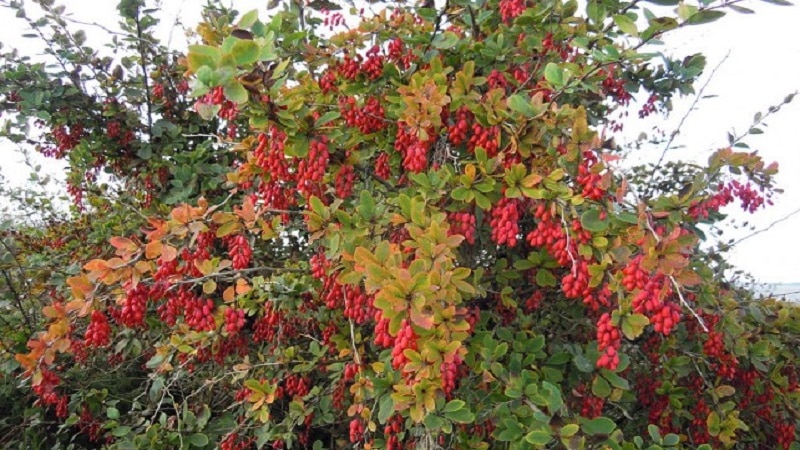
Types and popular varieties of barberry
There are several varieties of barberry and many varieties. Each has its own characteristics.
Common barberry
This species is popular in the Moscow region due to its frost resistance, drought resistance, and undemanding soil requirements.
The most decorative variety is considered to be Atropurpurea. The height of the barberry bush reaches 2 m. The leaves are red-brown. The berries are edible, purple-red, slightly sour. The plant bears fruit abundantly every year.
Barberry ottawa
Hybrid Barberry Thunberg and common purple leaf.Although the flowering bushes look stunning and can brighten up any garden, the variety is rare in our area. In autumn, the pink-violet leaves acquire a bright crimson hue, and scarlet fruits remain on the bushes.
Common varieties:
- Auricoma - up to 2.5 m high. The leaves are bright red in summer, orange in autumn. The flowers are yellow-red, up to 1 cm in diameter, collected in inflorescences.
- Superba is a spreading bush up to 3 m in height and up to 2-3 m in width. The leaves are reddish, the flowers are yellow, with red markings. The variety resembles purple-leaved barberry.
- Silver Miles - up to 2.5 m high, with a spreading crown. The leaves are purple-silver in color and covered with pink spots. The flowers are yellow-red.
The photo shows barberry fruits.
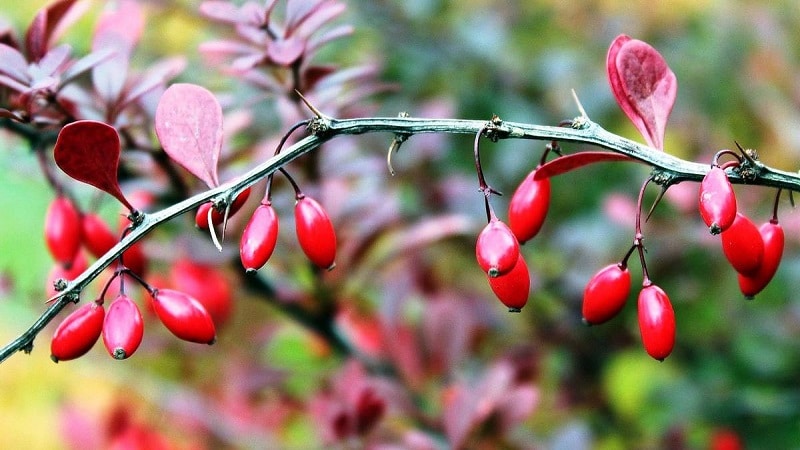
Barberry Thunberg
A plant species native to China and Japan. The bushes are medium-sized, up to 1.5 m high. In summer, the leaves are green, arched, and the shoots are inclined. In autumn, the foliage is mesmerizing with a riot of colors.
Common decorative varieties and forms:
- Admiration has a low growth vigor - bushes rarely exceed 0.5 m in height. The shape is spherical and dense, the crown is uneven. The leaves are glossy red-brown with yellow edges.
- Atropurpurea Nana is a popular barberry variety. The height of the bushes is 0.6 m, the diameter is 0.8 m. The foliage is purple in summer, red in autumn, there are few thorns on the shoots.
- Aurea - up to 1 m high. In the sun the leaves are yellow, in the shade light green, in the fall they turn pink or bronze.
- Bonanza Gold is a bush 0.4 m high, 0.8 m in diameter. Lemon leaves. The plant is resistant to sunburn.
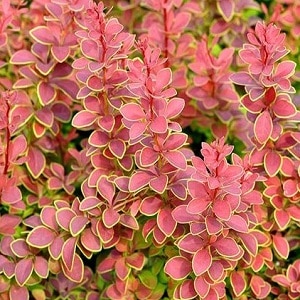
- Coronita is a shrub 0.8–1 m high, 1.5 m in diameter. The leaves are large, purple-red in color with a yellow edge.
- Dart's Red Lady is a 1m tall bush with shiny purple leaves.In autumn the foliage turns bright red.
- Erecta is a slow-growing thorny bush 1–1.5 m high. The crown is columnar. In summer the leaves are light green and turn coral in autumn.
- Golden Carpet is a bush 0.9 m high, 1.5 m in diameter. In spring the leaves are pink, with red edges, yellowish in summer, orange in autumn, light green in the shade.
- Golden Ring is a bush 1–1.5 m high and wide. The leaves are large purple with a yellow-green border.
- Golden Rocket is a shrub with a vertical crown, 1.2 m high. The leaves are yellow in summer and red-orange in autumn.
- Green Carpet is a bush with thorns, 1 m high, 1.5 m wide. In summer the leaves are green, in autumn they are yellow or orange with red splashes.
- Harlequin is a bush 1 m high and 1.5 m wide. The leaves are burgundy with white and pink splashes.
- Kobold is a bush 0.5 m high and wide. The crown is dense. The leaves are dark green in spring, turn pink in summer, and turn red in autumn.
- Maria is a bush with a dense crown, 1–1.5 m high and 0.5–1 m wide. The leaves are large yellow with pink edges, turning orange-red in autumn.
- Orange Rocket is a bush 1.2 m high and 0.6 m wide. The leaves are orange-red.
- Pink Queen is one of Thunberg's best strains. The bush is prickly, 1–1.5 m high, in the shape of a hemisphere. In summer, the leaves are red-purple with white and gray streaks, becoming carmine red closer to autumn.
- Red Rocket is a fast growing variety. Bush 1.5 m high. Columnar crown. The leaves are red-brown in summer and turn orange in autumn.
- Silver Beauty is a bush 1.5 m high and 1 m wide. The leaves are silver-variegated in color.
- Starburst is a thorny bush 1.2 m high and 1.5 m in diameter. The leaves are green in spring, covered with white and pink spots in summer, and turn red in autumn.
- Sunny is a thorny bush 1 m high, with a dense crown. The leaves are yellow in summer and red in autumn.
- Tiny Gold is a low-growing shrub 0.3 m high and wide. The crown is spherical. The leaves are yellow in summer and bright orange in autumn.
Rare varieties of barberry
Some types of culture are rare:
- Boxwood barberry is a variety that appeared in 1826. The bushes are tall, up to 3 m. The crop is recommended for cultivation in the south of Russia.
- Amur barberry is widespread in China and has been known since 1857. The bushes are tall, reaching 3 m. The leaves have finely toothed edges, 10 cm long. In spring and summer they are painted bright green, in the fall they turn red or orange-red. The flowers are fragrant light yellow. The Flamboyan variety has smaller leaves that are bright orange.
- Barberry Juliana comes from China. Evergreen shrub, freezes in winter. The height does not exceed 0.5–2 m (forest barberry reaches 3-4 m). The leaves are hard, glossy, with narrow teeth. The flowers are yellow, forming dense clusters of 15 pieces. The fruits are oblong blue-black.
Planting and care
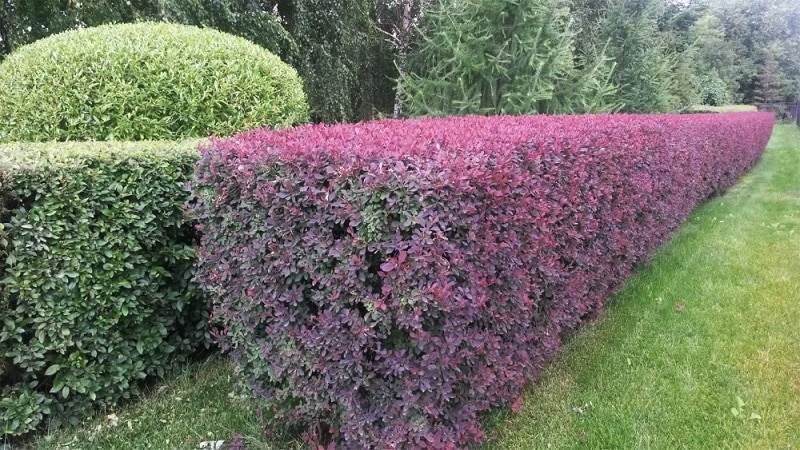
Judging by the reviews, barberry is not a very demanding plant, but for normal development it needs good lighting. The bushes can be planted in partial shade, but too shaded areas are not suitable. In full shade, the plant loses its decorative effect, the colored forms fade, and the leaves become covered with dark spots. The more sun, the brighter the foliage.
The culture is drought-resistant, does not tolerate stagnation of water, is undemanding to the type of soil, but grows best in neutral soil with slightly acidic and acidic pH. The bushes do not suffer from transplantation; even in summer they quickly produce shoots.
Barberries with a closed root system can be replanted during the season, with an open one - in the spring, before the buds open, or in the fall, after the leaves have fallen.
When planted alone, the bushes are placed at a distance of 1.5–2 m from other crops. To form a dense hedge, 4 plants per linear meter are planted, for a sparse hedge - 2 per meter. The trench planting method is preferable.
The next year after planting, the bushes are fed with complex fertilizers, including nitrogen. The site is regularly cleared of weeds, the soil is loosened and watered once a week. Each bush uses 10 liters of water. The tree trunk circle is mulched with sawdust, straw or peat.
Interesting! Barberry is used to decorate garden plots. In May - June, when the plant begins to bloom, and in the fall, when it lights up with scarlet fruits, the area around it looks amazing.
Columnar bushes are used in group plantings or as tapeworms. Low-growing varieties look advantageous in rockeries and small gardens. Thunberg barberry is used in Japanese stylizations.
Common barberry is used to create decorative hedges and hedges up to 3 m high. Shrubs with golden leaves are planted in the foreground of flower beds.
Reproduction methods
Barberry is propagated by layering, cuttings and seeds. Each method has pros and cons:
- cuttings root slowly;
- seed germination is within 20–40%, and varietal characteristics are often not preserved;
- dividing the bush increases the risk of damage to the root system;
- Root shoots are produced by some species and varieties of barberry.
Experienced gardeners advise experimenting with different methods.For example, Thunberg barberry is best propagated by cuttings: the plant produces many young shoots that are used as planting material. It is better to propagate coin barberry by seeds, since problems arise with the rooting of cuttings.
This is interesting:
A step-by-step guide to pruning felt cherry trees in summer for beginners.
How to properly water cherries in summer: instructions for novice gardeners
Seed method
From a small seed you can get a beautiful shrub, but given the low germination percentage, you will have to plant a lot of seeds. Large ripe fruits are used to collect seed. The seeds are washed in running water, kept in a light pink solution of potassium permanganate and dried.
Planting material is sown in the fall in loose soil, previously cleared of weeds, to a depth of 3 cm. Wintering hardens the seeds, and in the spring they sprout.
Reference. Spring sowing is carried out after preliminary preparation of the material: the seeds are kept at a temperature of +3°C for a week, then mixed with sand and planted at the end of April.
The seedlings are thinned out, leaving strong and healthy seedlings. The next year, the seedlings are transplanted into the garden, to a permanent place. Fruiting with this method of planting occurs after 2 years, before which the bushes are grafted.
Barberry also reproduces by self-sowing: the seeds from the berries fall into the soil and germinate in the spring. In autumn, full-fledged seedlings appear on the site.
Propagation by cuttings
Cuttings eliminate the need for grafting. Cuttings are taken from adult bushes, rooted and planted in a permanent place.To speed up the rooting process, growth stimulants are used, for example, “Kornevin”.
How to take cuttings:
- Cut cuttings 15 cm long from side branches at the end of June.
- Trim the lower leaves and treat the bases with Kornevin.
- Place the planting material in a mixture of peat and sand or perlite, and stretch the film on top.
- 2-3 times a day, remove the cover for ventilation, spray the plantings with water at room temperature.
- When the cuttings begin to grow, transfer them to containers with moist and loose soil fertilized with minerals.
- Next year, plant the cuttings in the garden.
This is interesting:
The benefits and harms of pears for women
The best summer pear varieties: description and characteristics
Division by layering
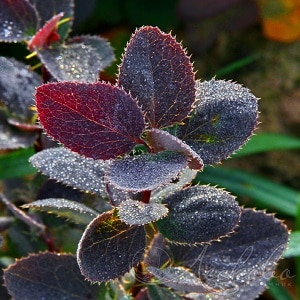
Reproduction by layering guarantees survival. A healthy and lush bush is divided into daughter plants or layering for rooting. In the first case, the mother bush is dug up and divided, large roots are sawed and planted in prepared holes.
Division by layering is carried out in the spring. For this, annual branches are chosen. Furrows are dug near the mother bush, weeds are destroyed, and the soil is shed abundantly with water.
The prepared shoots are placed in recesses, fixed and covered with soil, leaving the tops on the surface. During the season, the cuttings are regularly watered in order to obtain ready-made seedlings by autumn and preserve varietal characteristics.
Conclusion
In the botanical description, barberry is a shrub 2–2.5 m high, some varieties reach 3-4 m. The shoots are covered with light brown bark and thorns. In the spring, the leaves are colored light green, green and yellow, in the summer they become pink or orange, and in the fall they turn purple. Coloring varies depending on the species and variety.For example, Thunberg barberry has yellow foliage, while the Ottawa variety Silver Miles has purple-silver foliage with pink spots.
The plant prefers sunny places and partial shade, but fades in shade. Reproduction is carried out by seed, cuttings and division by layering. For each type and variety, they select their own method through trial and error. A common method is cuttings, since planting material takes root without problems. The seed method is less popular due to the low germination rate of seeds. Dividing by layering guarantees high survival rate and eliminates the need to graft bushes.